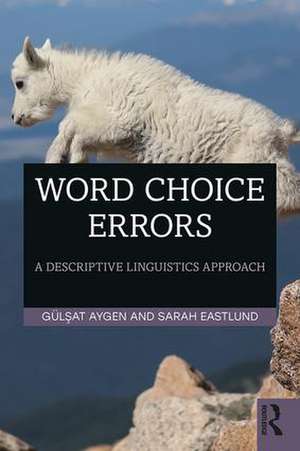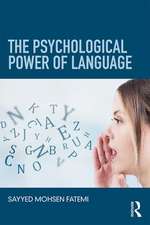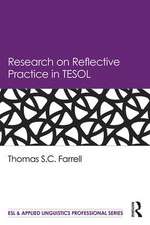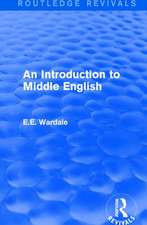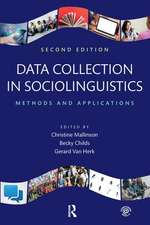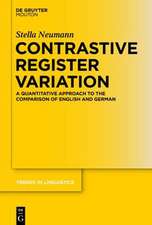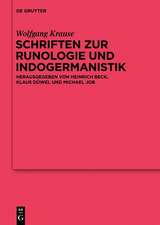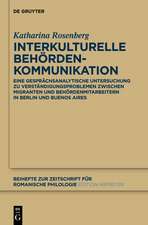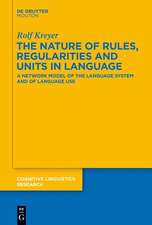Word Choice Errors: A Descriptive Linguistics Approach
Autor Gulsat Aygen, Sarah Eastlunden Limba Engleză Paperback – 14 aug 2019
| Toate formatele și edițiile | Preț | Express |
|---|---|---|
| Paperback (1) | 364.17 lei 6-8 săpt. | |
| Taylor & Francis – 14 aug 2019 | 364.17 lei 6-8 săpt. | |
| Hardback (1) | 764.20 lei 6-8 săpt. | |
| Taylor & Francis – 19 aug 2019 | 764.20 lei 6-8 săpt. |
Preț: 364.17 lei
Nou
Puncte Express: 546
Preț estimativ în valută:
69.72€ • 71.74$ • 58.77£
69.72€ • 71.74$ • 58.77£
Carte tipărită la comandă
Livrare economică 01-15 martie
Preluare comenzi: 021 569.72.76
Specificații
ISBN-13: 9780367203955
ISBN-10: 0367203952
Pagini: 214
Ilustrații: 100 Tables, black and white
Dimensiuni: 152 x 229 x 20 mm
Greutate: 0.32 kg
Ediția:1
Editura: Taylor & Francis
Colecția Routledge
Locul publicării:Oxford, United Kingdom
ISBN-10: 0367203952
Pagini: 214
Ilustrații: 100 Tables, black and white
Dimensiuni: 152 x 229 x 20 mm
Greutate: 0.32 kg
Ediția:1
Editura: Taylor & Francis
Colecția Routledge
Locul publicării:Oxford, United Kingdom
Cuprins
Preface
Acknowledgements
Chapter 1. Introduction: Inaccurate Word Choices and Linguistic Criteria
1.1. Morpho-Syntactic Criterion
1.2. Syntactic Criterion
1.3. Semantic Criterion
Review Exercises: Linguistic Criteria
Chapter 1 Recap
Chapter 2. Commonly Confused Words: Affect/Effect – Cue/Queue
2.1. Affect/Effect
2.2. Allude/Elude
2.3. Breach/Breech
2.4. Cache/Cachet
2.5. Capital/Capitol
2.6. Censor/Censure/Sensor
2.7. Cite/Sight/Site
2.8. Colombia/Columbia
2.9. Complement/Compliment
2.10. Confident/Confidant/Confidante
2.11. Conscience/Conscientious/Conscious/Consciousness
2.12. Cue/Queue
Review Exercises: Affect/Effect – Cue/Queue
Chapter 2 Recap
Lesson Learned
Chapter 3. Commonly Confused Words: e .g./i.e – Hail/Hale
3.1. e.g./i.e.
3.2. Either … or/Neither … nor
3.3. Elicit/Illicit
3.4. Emulate/Imitate
3.5. Emigrate/Immigrate/Migrate
3.6. Ensure/Insure/Assure
3.7. Envelop/Envelope
3.8. Everyone/Every one
3.9. Farther/Further
3.10. Gild/Guild
3.11. Grill/Grille
3.12. Hail/Hale
Review Exercises: i.e./e.g. – Hail/Hale
Chapter 3 Recap
Lessons Learned
Chapter 4. Commonly Confused Words: It’s/Its – Right/Rite/Write
4.1. It’s/Its
4.2. Lay/Lie
4.3. Less/Fewer
4.4. Let’s/Lets
4.5. Loose/Lose
4.6. Moral/Morale
4.7. Onto/On to
4.8. Quiet/Quite
4.9 Principal/Principle
4.10. Raise/Raze
4.11. Rational/Rationale
4.12. Right/Rite/Write
Review Exercises: It’s/Its – Right/Right/Rite
Chapter 4 Recap
Lesson Learned
Chapter 5. Commonly Confused Words: Setup/Set up – Your/You’re
5.1. Setup/Set up
5.2. Shear/Sheer
5.3. Sic/Sick
5.4. Their/There/They’re
5.5. Than/Then
5.6. To/Too/Two
5.7. Vain/Vane/Vein
5.8. Well/Good
5.9. Weather/Whether
5.10. Were/We’re/Where
5.11. Wet/Whet
5.12. Which/Witch
5.13. Whose/Who’s
5.14. Your/You’re
Review Exercises: Setup/Set up – Your/You’re
Chapter 5 Recap
Lesson Learned
Chapter 6. Cumulative Application
Summary Points
Chapter 7. Conclusion
Answer Key for Fill-in-the-Blank Exercises
Consulted Works
Glossary
Index
Acknowledgements
Chapter 1. Introduction: Inaccurate Word Choices and Linguistic Criteria
1.1. Morpho-Syntactic Criterion
1.2. Syntactic Criterion
1.3. Semantic Criterion
Review Exercises: Linguistic Criteria
Chapter 1 Recap
Chapter 2. Commonly Confused Words: Affect/Effect – Cue/Queue
2.1. Affect/Effect
2.2. Allude/Elude
2.3. Breach/Breech
2.4. Cache/Cachet
2.5. Capital/Capitol
2.6. Censor/Censure/Sensor
2.7. Cite/Sight/Site
2.8. Colombia/Columbia
2.9. Complement/Compliment
2.10. Confident/Confidant/Confidante
2.11. Conscience/Conscientious/Conscious/Consciousness
2.12. Cue/Queue
Review Exercises: Affect/Effect – Cue/Queue
Chapter 2 Recap
Lesson Learned
Chapter 3. Commonly Confused Words: e .g./i.e – Hail/Hale
3.1. e.g./i.e.
3.2. Either … or/Neither … nor
3.3. Elicit/Illicit
3.4. Emulate/Imitate
3.5. Emigrate/Immigrate/Migrate
3.6. Ensure/Insure/Assure
3.7. Envelop/Envelope
3.8. Everyone/Every one
3.9. Farther/Further
3.10. Gild/Guild
3.11. Grill/Grille
3.12. Hail/Hale
Review Exercises: i.e./e.g. – Hail/Hale
Chapter 3 Recap
Lessons Learned
Chapter 4. Commonly Confused Words: It’s/Its – Right/Rite/Write
4.1. It’s/Its
4.2. Lay/Lie
4.3. Less/Fewer
4.4. Let’s/Lets
4.5. Loose/Lose
4.6. Moral/Morale
4.7. Onto/On to
4.8. Quiet/Quite
4.9 Principal/Principle
4.10. Raise/Raze
4.11. Rational/Rationale
4.12. Right/Rite/Write
Review Exercises: It’s/Its – Right/Right/Rite
Chapter 4 Recap
Lesson Learned
Chapter 5. Commonly Confused Words: Setup/Set up – Your/You’re
5.1. Setup/Set up
5.2. Shear/Sheer
5.3. Sic/Sick
5.4. Their/There/They’re
5.5. Than/Then
5.6. To/Too/Two
5.7. Vain/Vane/Vein
5.8. Well/Good
5.9. Weather/Whether
5.10. Were/We’re/Where
5.11. Wet/Whet
5.12. Which/Witch
5.13. Whose/Who’s
5.14. Your/You’re
Review Exercises: Setup/Set up – Your/You’re
Chapter 5 Recap
Lesson Learned
Chapter 6. Cumulative Application
Summary Points
Chapter 7. Conclusion
Answer Key for Fill-in-the-Blank Exercises
Consulted Works
Glossary
Index
Notă biografică
Gülşat Aygen is Professor of Linguistics and a Distinguished Teaching Professor at Northern Illinois University, USA.
Sarah Eastlund is Assistant Professor of English at Brescia University, USA.
Sarah Eastlund is Assistant Professor of English at Brescia University, USA.
Recenzii
"This unique book systematically guides students through structural, semantic, and strategic criteria to help them distinguish such difficult pairs as affect/effect, principal/principle, farther/further. Simultaneously, students learn the basics of structural linguistics. Copious exercises and other mnemonics facilitate internalization of the targeted distinctions."
D. Gary Miller, University of Colorado Boulder, USA.
"Language learners are often told just to memorize words from the dictionary, but that makes language look like a mess of irregular and arbitrary words. Aygen and Eastlund identify common errors and explain how linguistic form, meaning, and structure can be used to correct these mistakes. This book provides advanced English learners with the tools they need to figure out the regularities of language, giving them practice at linguistic skills to make their own linguistic generalizations. Aygen and Eastlund have created a very useful text, full of exercises which clearly test progress. It's an incredible resource for both learners and teachers."
Claire Bowern, Yale University, USA.
"Teachers of writing most often focus on such global concerns as organization, development, and coherence. At the same time, learners, especially English learners, can concern themselves with making appropriate choices at the word level. An instructor’s prescriptive approach offers general rules and sometimes admonishments. As a wise alternative, Aygen and Eastlund, in their Word Choice Errors: A Descriptive Linguistics Approach, show students how to interrogate errors to understand their causes and then devise practices that will help them to become more precise and confident writers. This useful book helps emerging writers to make choices based on linguistic principles and not based on recall of prescriptions nor intuition."
Thomas M. McCann, Northern Illinois University, USA.
D. Gary Miller, University of Colorado Boulder, USA.
"Language learners are often told just to memorize words from the dictionary, but that makes language look like a mess of irregular and arbitrary words. Aygen and Eastlund identify common errors and explain how linguistic form, meaning, and structure can be used to correct these mistakes. This book provides advanced English learners with the tools they need to figure out the regularities of language, giving them practice at linguistic skills to make their own linguistic generalizations. Aygen and Eastlund have created a very useful text, full of exercises which clearly test progress. It's an incredible resource for both learners and teachers."
Claire Bowern, Yale University, USA.
"Teachers of writing most often focus on such global concerns as organization, development, and coherence. At the same time, learners, especially English learners, can concern themselves with making appropriate choices at the word level. An instructor’s prescriptive approach offers general rules and sometimes admonishments. As a wise alternative, Aygen and Eastlund, in their Word Choice Errors: A Descriptive Linguistics Approach, show students how to interrogate errors to understand their causes and then devise practices that will help them to become more precise and confident writers. This useful book helps emerging writers to make choices based on linguistic principles and not based on recall of prescriptions nor intuition."
Thomas M. McCann, Northern Illinois University, USA.
Descriere
American English has many word pairs and trios that are alike enough to be confusing. Word Choice Errors provides a novel way to empower writers of all levels to cut through the confusion to understand which word to use and why that’s the word to use.
